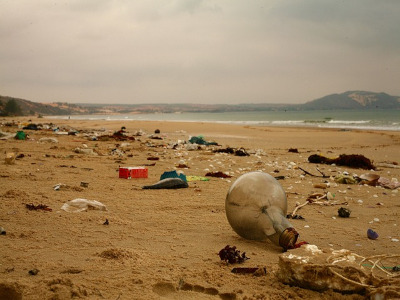The word plastic originally meant ‘pliable and easy to shape’. Plastics are a variety of synthetic or semi-synthetic materials, the main constituents of which are polymers. Polymers are plastic, and that allows plastics to be shaped, extruded, or pressed into solid objects. Plastics are also light weighted. They are very durable and flexible, and their production costs are also low. These are the main reasons why they are used so widely. Most of the plastics are made from fossil fuel-based chemicals. Nowadays, renewable materials like corn and cotton derivatives are also used for making plastic. The first fully synthetic plastic was invented in 1907 by Leo Baekeland, and it was called Bakelite. Between 1950 and 2017, more than 9.2 billion metric tons of plastic were produced. It is estimated that by 2050, the annual plastic production may reach 1.1 billion metric tons. The popularity of plastic has caused a lot of environmental problems. Because they decompose in nature really slowly. Most of the plastics that are produced are not reused, or they can’t be reused. The plastic is either in landfills or remains in the environment as polluters and microplastics.
Plastics are mainly used in packaging and in buildings, for example, in pipes, plumbing, and vinyl siding. Plastics are also used to build cars, furniture, and toys. Around 50 kg of plastic is produced annually per person.
Microplastics are small plastic pieces. Microplastics are plastics that are smaller than five millimetres. Microplastics are categorized into two categories: primary and secondary. Primary microplastics come from everyday use. For example, in cosmetics (for example, they have been found in exfoliating skincare), microfibres from clothing, and other textiles. Secondary microplastics are from bigger plastic items and are the result of their breakdown. It happens mainly because of different environmental factors, like the sun’s radiation and ocean waves. Microplastics pollute the environment. Unlike the natural products, they don’t breakdown into harmless molecules. They are harmful to the environment and also to all living things there. It takes hundreds or even thousands of years for plastic to decompose. Microplastics are visible at the beach as tiny, multicoloured pieces in the sand. In the oceans, marine animals eat the microplastics.
Microplastics are detected in the smallest sea animals, like plankton, to the biggest ones, whales. It is also inside the commercial seafood and also inside our drinking water.
For a few years, scientists have found microplastics inside marine animals. In 2017, Belgian scientists said that seafood lovers eat up to 11, 000 plastic particles per year. If you eat fish, then you don’t have to worry that much because we don’t eat them as a whole. However, if you like mussels, then you might eat them along with microplastics. Scientists have found that plastic can decompose into smaller pieces, like the size of human hair. They can also become almost invisible to human eyes. Scientists have noticed that we breathe in more plastic than we actually eat with food. These tiny fibres are from our clothes, carpets, and upholstery. In 2022, scientists found microplastic inside a living human. They were inside the lungs and blood. With this study, the scientists weren’t able to answer the question about the harmfulness of plastic inside our body, but our body is definitely not a place for plastic.
The research for possible side effects of plastics started around forty years ago. It started with animals, and scientists were studying seabirds. The study expanded to other marine animals as well, including rats and mice. In 2012, scientists came out with results that said that all seven sea turtle species, 45% of marine animals, and 21% of seabirds are affected by plastic. They either have eaten it, or they have been entangled. Laboratory studies say that the plastic inside the fish causes harm to their reproductive system and liver stress.
Animal studies inform us about possible side effects on human physiology and toxicological side effects. Although this area is still very new because plastic hasn’t been in nature for a long time. For example, in 2019, scientists fed purposefully to the quail chicks plastic toxin. The result was opposite of what was expected. The quail had minor delays in growth and maturation. From this study, the scientist said that maybe carrying a small amount of plastic in the body is not as dangerous as expected. But that being said, scientists still don’t know what the impacts of eating plastic are or what it does to the human body. The biggest reason why it is difficult to know what the side effects are on the human body is that we cannot deliberately feed people plastic.
In laboratory tests with microplastics, scientists have noticed harmful effects on human cells. Microplastics can cause allergic reactions, and they can also cause cell death. In the 2018 study, they found plastic on people’s faces. Microplastic has also been found in the placentas of unborn babies. And yet again, these studies were done with a small group of people, which means drawing conclusions is hard. It’s not only the microplastics that may cause harm. The chemicals that are used to produce the plastics can also be harmful. These chemicals can get into our bodies, for example, from water bottles. The chemicals leach into the water we drink. And they can cause endocrine disruption, weight gain, insulin resistance, decreased reproductive health, and cancer. However, as already mentioned, more detailed studies are needed to be done to allow a more accurate conclusion to be made about exposure to microplastics and their potential effects on human health.

Sources:
https://en.wikipedia.org/wiki/Plastic
https://sciencehistory.org/education/classroom-activities/role-playing-games/case-of-plastics/history-and-future-of-plastics/
https://education.nationalgeographic.org/resource/microplastics/
https://www.nationalgeographic.com/environment/article/microplastics-are-in-our-bodies-how-much-do-they-harm-us
https://www.undp.org/kosovo/blog/microplastics-human-health-how-much-do-they-harm-us
